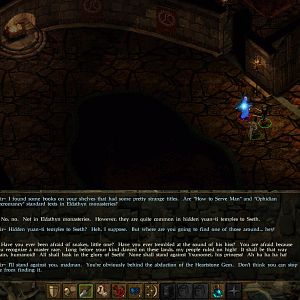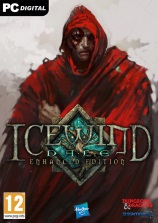-

- Forums
- Chatrooms
- Gallery
- Gameplay Videos
- Upload
- Articles
- Mod Reviews
- Shop SP: Games, Movies, Books

Origins | Ostagar | Lothering | Circle Tower | Warden's Keep (DLC) | Return to Ostagar (DLC) | Stone Prisoner (DLC) | Brecilian Forest | Redcliffe | The Urn of Sacred Ashes | Orzammar | Deep Roads | Denerim | Final Onslaught |
Character Development | Equipping Characters | Combat Guidelines |
COMBAT GUIDELINES
Below are a number of general guidelines for the conduct of combat in Dragon Age Origins (Nightmare), which will be fleshed out through specific examples in other parts of the guide.
Maximize your Physical Combat Advantages: Attack and Defense, then Armor and others
I started this thread even though I for the most part agreed with Blackthorne TA's response in order to start some debate. Armor remains static, and gets chipped away as higher level foes have more Armor Penetration. Attack and defense can always be built up on level ups. Given this dynamic it is usually more important to minimize the number of times you get hit, and maximize the number of times you hit the enemies, than to rely on damage reduction.
There are times when both your party and the monsters are crowding around each other and mixing it up. It is often the 'default situation'. It therefore pays to maximize your attack and defense ratings for your characters, with armor and other factors coming second.
This is not to say that every battle can be run on auto-pilot. Prudence dictates calling upon other strategies as well, like exercising crowd-control. Even so, paying attention to attack and defense and armor ratings is still important. Higher attack and defense ratings can accentuate other strategies like crowd-control and holding the swarm at bay. For example, if only a few monsters make it past crowd-control, your higher attack and defense ratings will make themselves that much more effective on the fewer number of foes that reach you. Likewise greater attack and defense ratings also mean taking down monsters stunned by Captivating Song for example much more quickly.
Minimally Scripted Mage as the Quarterback, Highly Scripted Warriors and Rogues
I'll provide more specific examples of this when I go over how I develop my Grey Warden and the companions. Many of the Mage's abilities are capable of friendly fire, or otherwise require precise placement in order to be effective such that their operation should not be left to scripting. I thus tend to prefer minimal scripting of activated abilities for a Mage, whom I have as the character that I control manually while the Warriors and Rogues go to work according to their much more extensive scripting. This also has the advantage in that a Mage who hangs back will have a much better view of the field of combat, thus allowing you to stay on top of things as they progress. *Note* This concept assumes holding the camera in an over the shoulder view instead of a straight down from the top view.
Avoid the Rush
It can be tempting to rush through the door and get the fight over with quickly. But this can lead to disaster. Sometimes other options are preferable. Sometimes you can seize the initiative right away and cast spells through the door. If the foes are right at the door when you open it, retreat a little and let them come to you so you're not relying on one or two characters against many right at the door. Take your time, be patient, and assess the situation as it develops.
Drawing them Forward
The idea is to pull a few foes away from the main force so that you can deal with them piecemeal.
One way to do this is to toggle the button on the left side of the screen so that your party members won't follow each other around. Send one character ahead of the party and bring the outlier enemies into view. When they start following the lead character, the lead character runs back and allows the party to easily kill them. The Mabari Hound, with his running speed, is probably the best suited for this role.
The other way is to open missile fire on the foremost among the enemy, which often encourages them to come forward ahead of the rest of the force. In fact Leliana often took this as far as wiping out whole parts of the enemy force one by one with her bow.
Turn the Corner
If you're faced with a large group of archers, an effective method is to run back and around the corner. Once they come around the bend they'll be within easy reach.
Crowd Control at the Bottleneck followed by Offensive Spells
This tends to work best when the foes are at the other end of a hallway, allowing you to use the hallway itself as a bottleneck. The idea is a simple and effective one. Start off with crowd-control spells in order to keep the monsters from passing the bottleneck. Good choices include Earthquake and the Glyph of Repulsion. Now fire away with offensive spells. It gets even better with storm type spells like Tempest, Inferno, and Death Cloud.
Keeping the Swarm at Bay
Sometimes this is unavoidable. You'll get swarmed with foes in an instant from all sides. It is therefore important to have talents that will halt the swarm in its tracks, both to stop you from getting overwhelmed but also to buy you time to go to work on them. Some of the best ones include Waking Nightmare, Blood Wound, and the Captivating Song.
The Singularly Powerful Foe
Sometimes you run into a particularly powerful monster like a Dragon, a Revenant, or a Pride Demon. It is recommended that you bring along abilities that can fulfill any one of three purposes. One purpose is to bring the monsters to a temporary halt, allowing your party members to score as much damage as possible until it manages to break free. Examples include Cone of Cold, the Glyph of Paralysis, and Petrify. Another purpose is to reduce its ability to inflict damage on you. One example is Misdirection Hex. Another purpose is to increase your ability to physically inflict damage on it. Examples include Death Hex and Telekinetic Weapons.
Enemy Mages
For enemy Mages the name of the game is to kill them as quickly as possible, interrupt their spellcasting whenever possible, or hold them up long enough for your party members to reach them (or some combination of those strategies).
Mana Clash is arguably the best anti-Mage ability in the game since it often kills enemy mages outright. Even if it doesn't, they'll be drained of their mana. It covers a large area as well and does not inflict friendly fire.
Crushing Prison is also a good ability since it both damages and paralyzes an enemy Mage for a decent amount of time.
Sometimes you need to interrupt Mages when they're in the middle of spellcasting though. Abilities that can knock opponents down or stun them can get the job done. Examples include Fireball, Scattershot, and Stone Fist.
Alistair makes one of the best Mage killers in the game, since he can combine delay with spellcasting interruption. He can start off with Holy Smite on a Mage, temporarily stunning him. Alistair then has enough time to walk up to the Mage and stay on top of him with Shield talents that can keep the Mage off his feet. Death is usually a matter of course.
'Aggro' Management
"Aggro" is CRPG jargon for a monster's tendency to make a bee-line for the character who has recently inflicted considerable damage on the monster, or otherwise has done something to get that monster's hostile attention.
A properly designed tank character is one that scores reliable damage, and has both good attack and defense ratings, and perhaps good armor to boot as well. As much as possible you want enemy aggro focused on your tank, to minimize the risks to other party members.
The more difficult question is when a physically more vulnerable character, like your Mage, does something to aggro the monsters. Spells like Earthquake and Fireball tend to produce a lot of aggro. The question then becomes how to neutralize that aggro. Aggro neutralization requires follow-up abilities that minimize the monsters' abilities to inflict damage on the vulnerable character. This will become clearer when I explain how I develop my Grey Warden character, Aldarion, as well as Wynne.
*Note* If you want specific examples of how I employ these guidelines, the rest of the guide contains numerous examples of how I conduct battles throughout the game.


